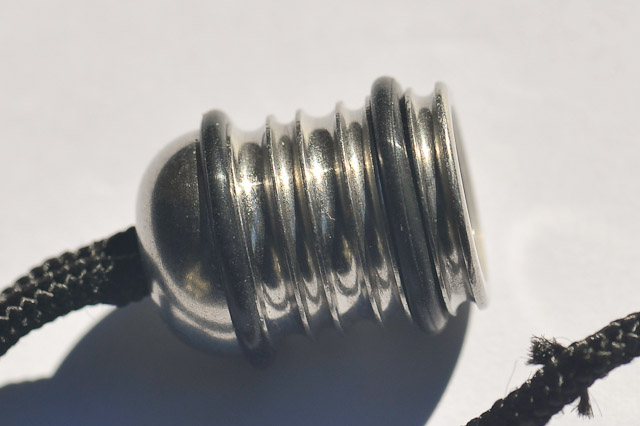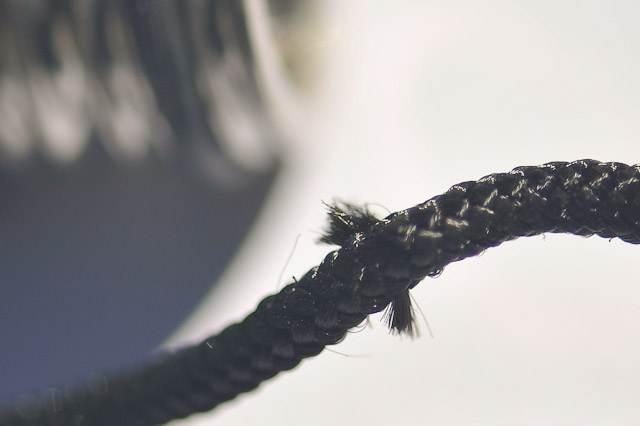
So I’ve had the Luma Loop strap for about a month now. I’ve barely used it but I’ve already found two problems that cause me concern about the design and materials. On the first day out with the strap I was shooting the world superbikes and had the strap attached to my Nikon D3 and a 70-200mm lens. As soon as I got back to the media centre I noticed that the dongle was missing two of the rubber rings. You might say no worries – but it is a worry because it seems the purpose of the rubber rings is to stop the metal hitting parts of the camera body like the rear LCD. I can easily imagine a solid hit will crack or chip the glass or the camera body. A simple fix would be to glue the rubber bits to the dongle. I wonder why that’s not done? Here’s a photo:

The second problem is even more concerning. I’ve noticed that there is already fraying on the cord that attaches the dongle to the camera body. If this is the result of a month of use, I’m worried about how strong the nylon is. I really don’t want my camera to drop off my body because the cord failed.

I’ve emailed Luma – let’s see what their response is.
Luma’s reply:
Greg Koenig, Mar-19 19:58 (PDT):
Hello Syd,
First off, thank you for giving us the opportunity to respond to your concerns! Your two issues are quite valid, and I would like to provide a response that is both open and detailed. Unfortunately, that also means my reply is somewhat exhaustive and lengthy. For this, I apologize. I would rather you have too much information than too little!
For the sake of efficiency, I’ll respond in sort of a long bullet point format:
On the O-Rings:
– The problem we’ve run into is that the O-rings get installed by hand, and some of them are getting stretched beyond their deformation point, making them fit very VERY loose. We never ran into this problem during our prototype rounds, as the sort of attention to detail that goes into assembling a prototype prevented this from happening.
– We have significantly improved the issue between production batches (looking at shipping records, yours was from the first large batch to be produced). While the O-rings issue still exists, it has gotten significantly better.
– That isn’t good enough, so we are currently having a tool crafted that will allow us to slip O-rings onto the Lanyard that are significantly undersized. This entirely solves the problem, but the creation of such tooling takes some time (we anticipate it will be up and running within the next 10-14 days, barring unforeseen problems).
– Once the O-ring solution has been found, we will be offering an exchange program; you email us and tell us how many replacement lanyards you need, we ship them to you, and you ship the old ones back. This will be announced on our email list, website and Twitter feed as soon as possible (and trust me, I want to get this solved faster than anybody!)
– The Lanyard without any O-rings has been designed to not have any edges sharp enough to scratch your camera. Of course, it is still a stainless steel part, so no guarantees of zero damage, but it has been sufficiently smoothed to keep from marring camera surfaces in relatively heavy testing.
– We experimented with using glue, but found that it was WAY too messy in a production environment. Gluing one or two lanyards is one thing, but gluing them in volume and keeping prices within reason is difficult. Personally, I am a huge fan of using adhesives in manufacturing, but this typically requires highly specialized tooling (often robotics) to keep the process from being anything more than a complete mess (to say nothing of keeping within environmental codes). The smaller, stiffer O-rings we are moving to solve the problem just as well as an adhesive would, but without the manufacturing complexity or massive (USD$15,000+) capital investment.
On the Fraying:
– The Lanyard is built around a 2mm nylon cord that is constructed like a miniature climbing rope. It is of a kernmantle design… the “kern” is the set of inside fibers that do the vast majority of the weight bearing while the “mantle” is an outside sleeve designed to protect the kern fibers from abrasion or environmental wear. Our nylon cord is built by Sterling Rope here in the United States, one of the world’s foremost technical rope constructors, and is rated to a *minimum* breaking strength of 300lbs. The mantle fibers are treated to further help prevent abrasion and the kern fibers are colored bright orange so any fraying can be quickly identified.
– The Lanyard system has been tested extensively across a broad array of cameras. Of course, most camera strap mounting points are designed for use with a nylon strap material, so they are carefully smoothed to prevent fraying. Given how important fraying is, we never would have moved ahed with the design if our routine testing across this broad assortment of cameras showed any evidence of fraying.
– Between Loop 1 and Loop 2, we have thousands of straps in the field. Loop 1 utilized far less sophisticated cord (military parachute cord with the kern fibers removed, essentially just a nylon sheath). With the exception of a few PodMounts that were slightly too sharp (and recalled quickly, as only a handful went out), the cord itself has never shown itself to be vulnerable to fraying in the field. This includes the previous cord design which, like I said, was really nowhere near as robust as what Loop 2 is built around. Bottom line: we have thousands of Loop 1s and Loop 2s in the field under arduous conditions and neither of our Lanyard designs has ever failed.
– I might also note that Op/Tec, the largest aftermarket camera strap manufacturer out there, also uses the same basic cord design. Their system utilizes an even thinner cord than ours, yet we have yet to hear of any Op/Tec system failures.
– From the picture on your blog post, it appears your Lanyard has been nicked. Frayed cord has a slightly different appearance where the cut fibers are of a non-uniform length and there is discoloration from abrasion heat. A nicked cord is where a small, sharp object has actually cut the fibers. On your system, this may have happened in production or it could have happened in the field. Typically, such a nick is not a mission critical failure point as it is damage from a discrete event (where abrasion, especially at the camera connection, is an ongoing force that will continue to produce damage).
– Either way, our policy is always the same; we will simply ship you a replacement lanyard as a warranty issue!
Thank you for writing! Again, I apologize for the length of my reply, but I wanted to give you an open and honest response!
Greg Koenig
CoFounder/Product Design Lead
Luma Labs LLC, PDX OR USA
http://lu.ma